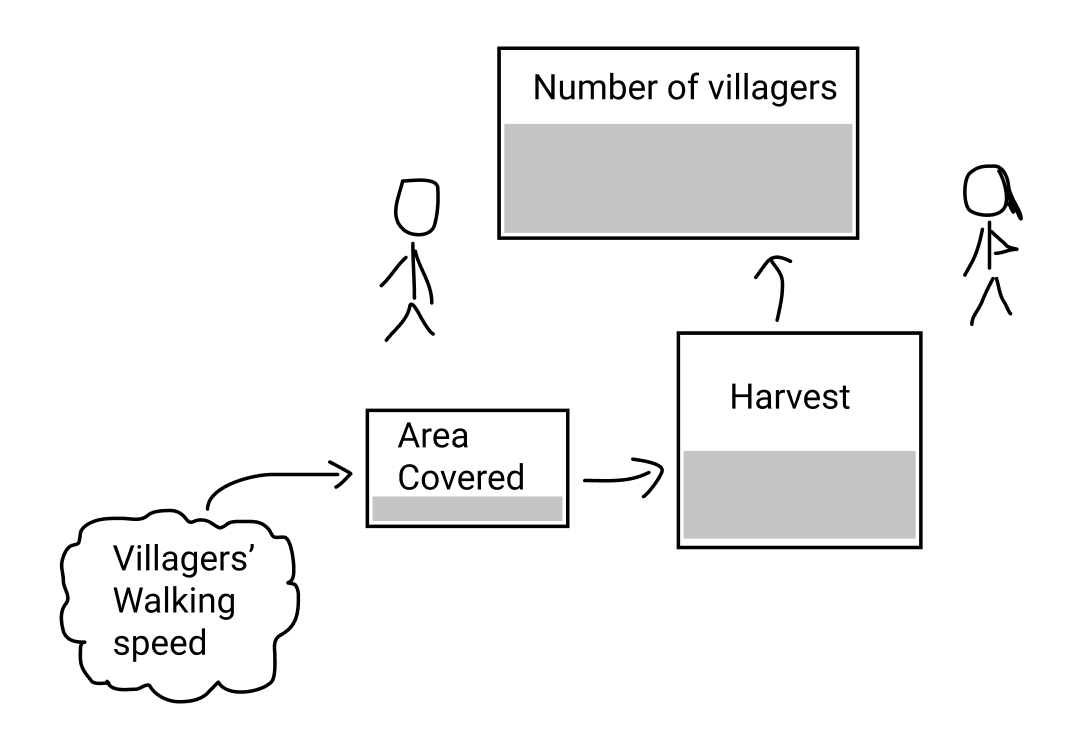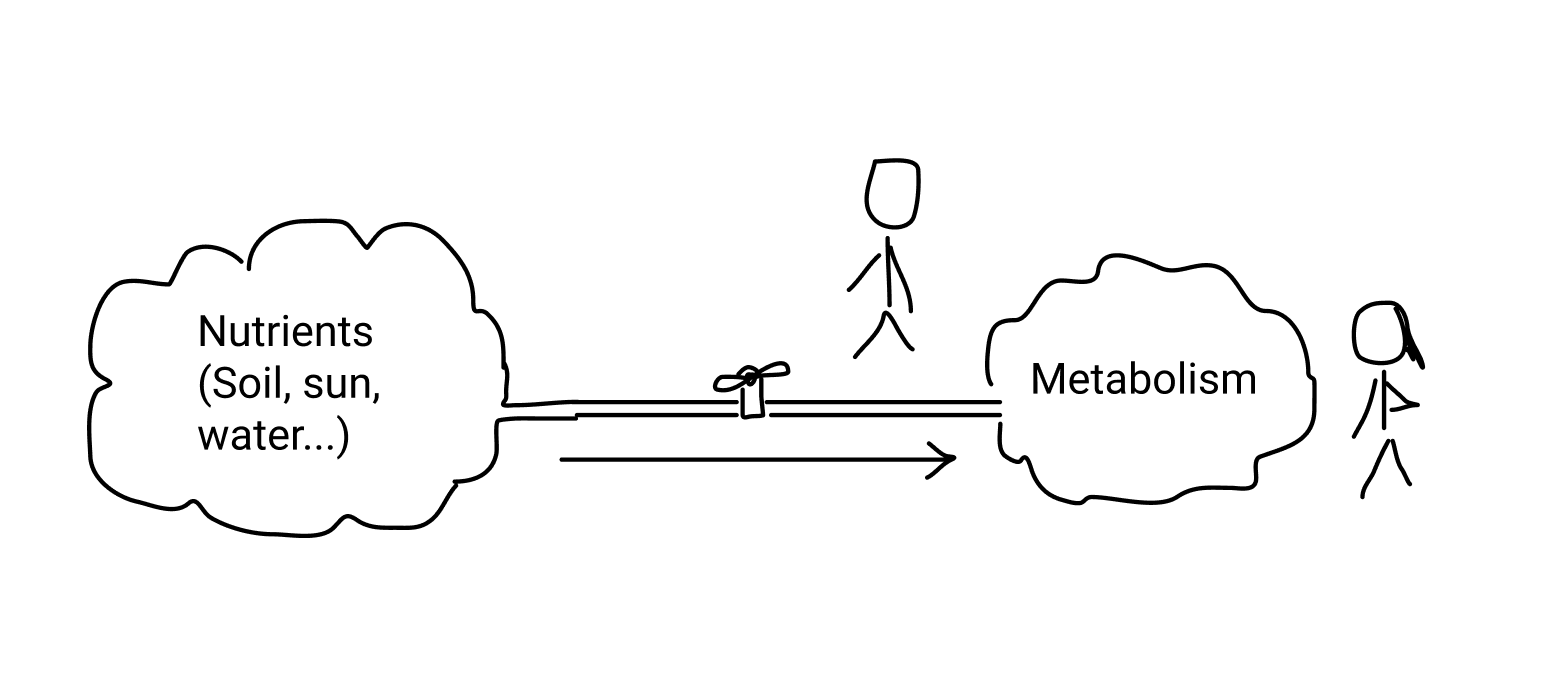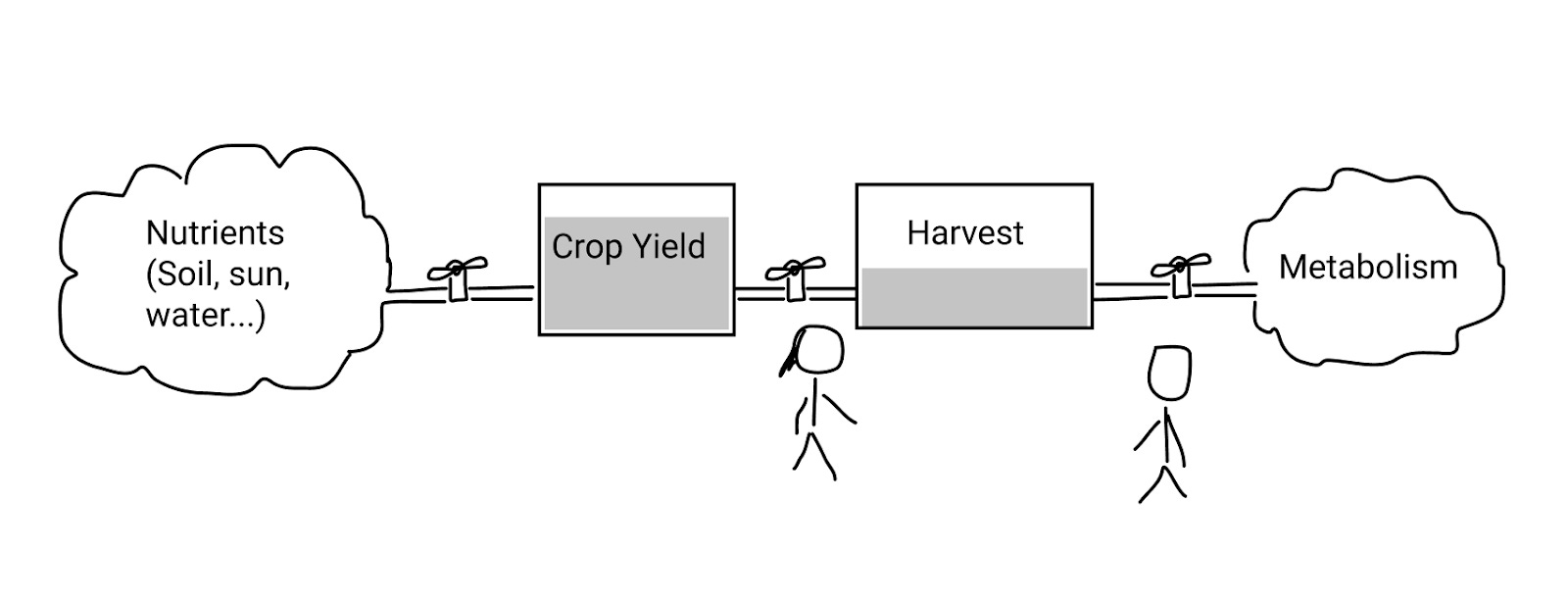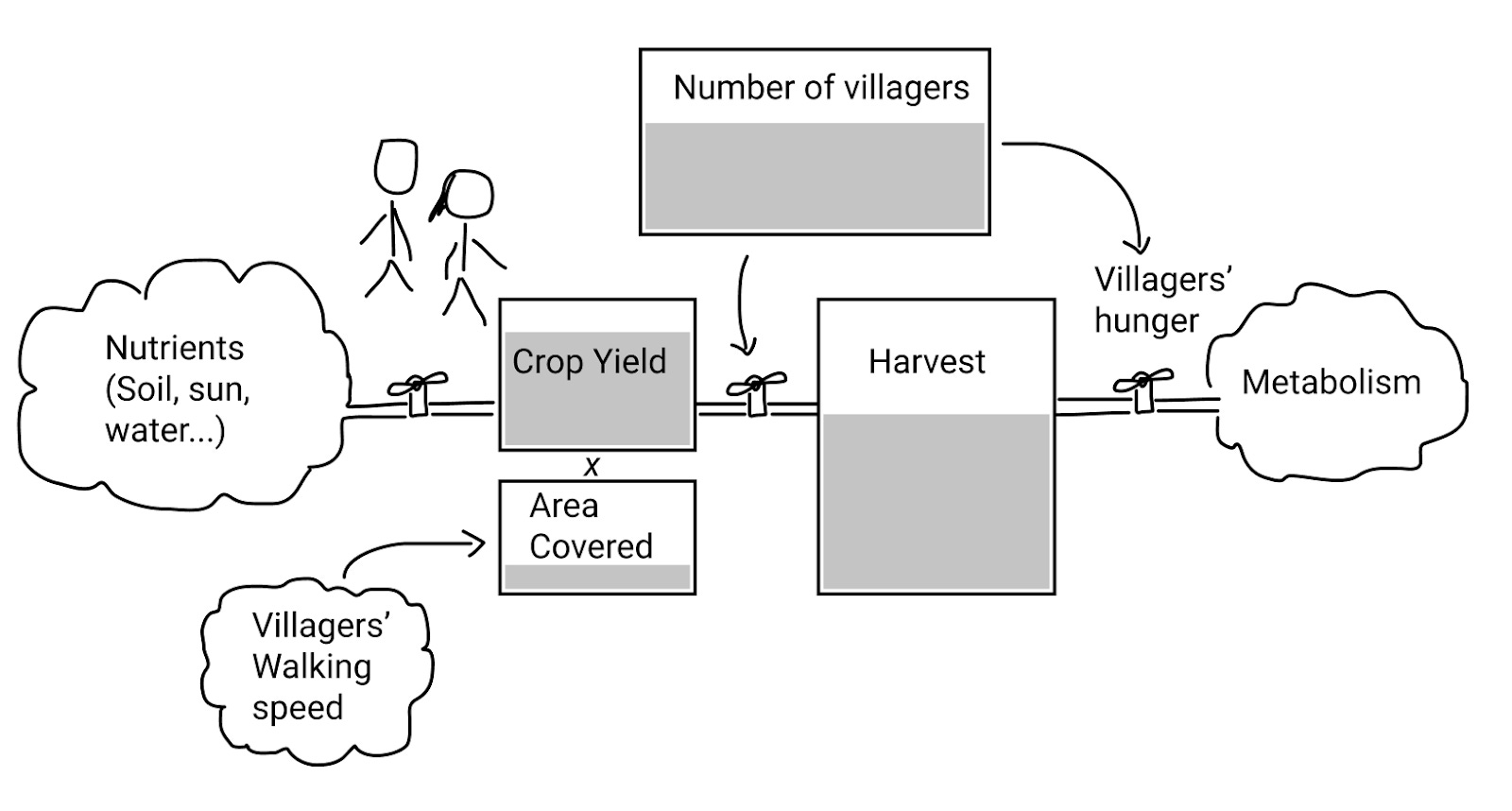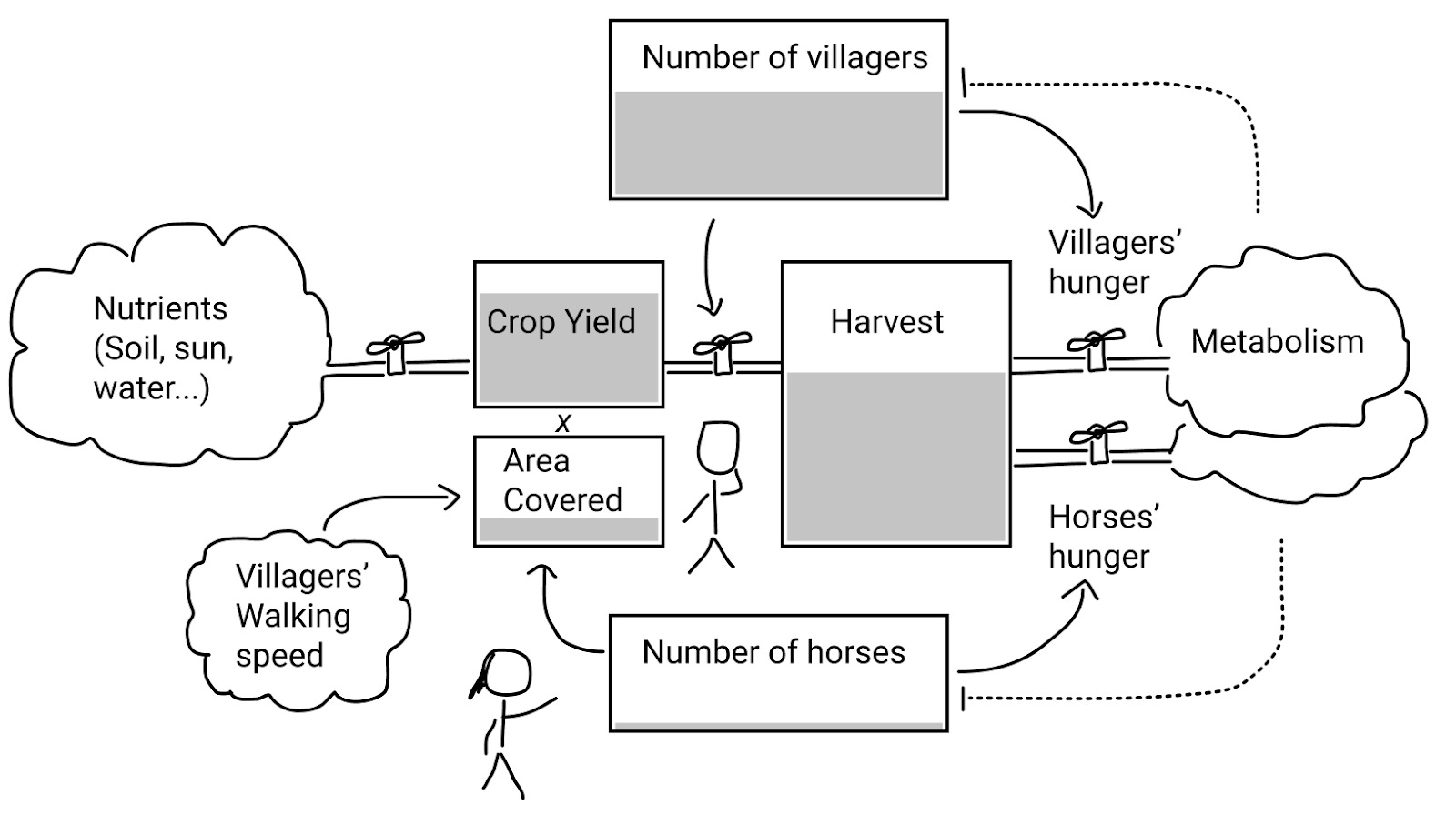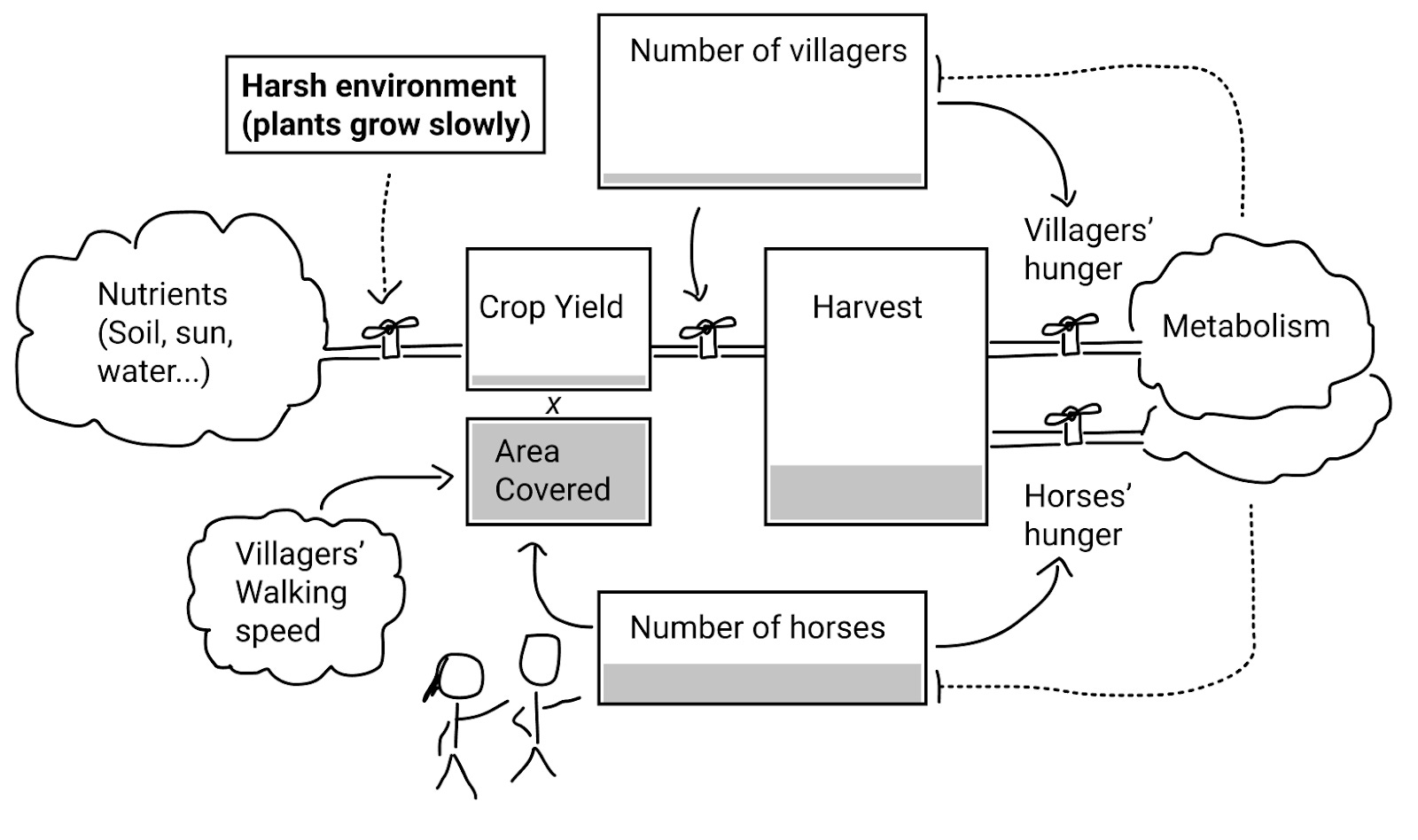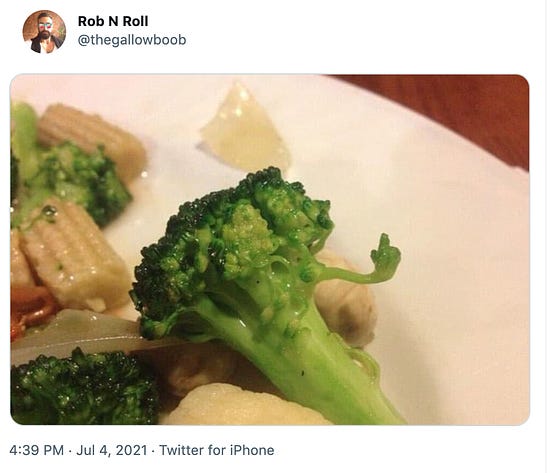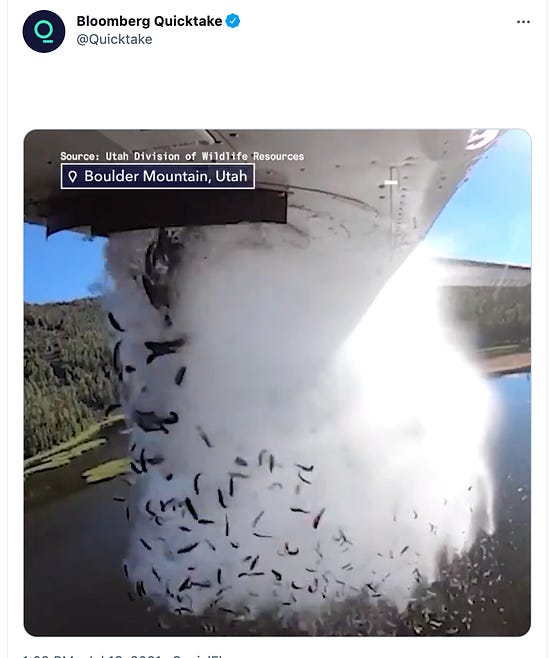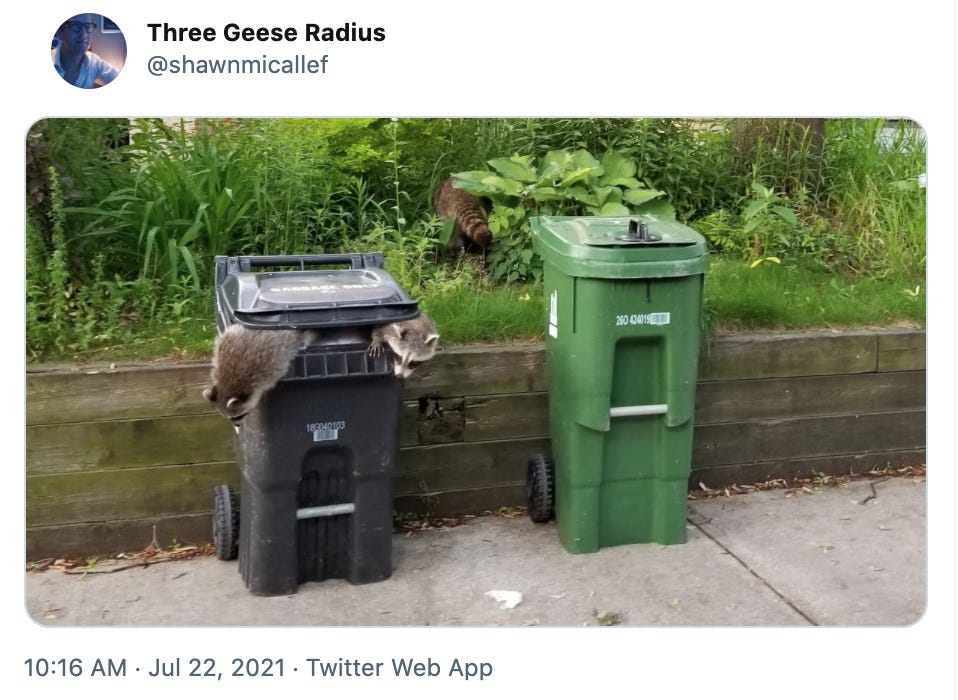Alex Danco's Newsletter - Dancoland, Part 2: Just-So Stories
Welcome back to Dancoland. If you missed part one last week, read that first. Teacher: Ok, let’s examine some of those things you told me about your village. I’d love to see what assumptions are behind them. Student: Okay, so like I said. When I look at all of these building blocks of what I know - how fast we walk, how we farm our food, and how big our village is - I see some pretty clear cause-and-effect relationships. A) this is how fast we walk, leads to B) how far out we can reach each day, leads to C) how large a harvest we can collect, leads to D) how large a village we can support. If it gets any bigger, we go hungry. Pretty clear to me. Teacher: Thank you for helping me see your thought process. You’re certainly more familiar with your village and your farming than I am. But I’m skeptical that this system actually works the way you’ve presented it. I have a strong suspicion that you’ve told me a just-so story. Student: What’s a just-so story? Teacher: Whenever you hear an explanation for why a system works the way it does, with a neat, tidy conclusion, and you hear an answer that goes, “because it is just so.” As an example, you may have wondered: why do Giraffes have such long necks? If someone told you, “because that’s precisely how high the leaves on the savannah trees are”, that is in fact a correct observation. But you ought to be suspicious of any kind of cause-and-effect conclusion you draw from that. Both the giraffes and the trees live inside a system. Same with your village: your crops, your harvest, and your villagers all exist inside a system. Student: I’ll certainly agree with that. There are lots of factors in my village that go into the details of how we farm. I’ve learned about them over the course of my life. But I don’t see what’s in conflict with my cause-and-effect conclusion I laid out for you. Teacher: Maybe I can show you something. How about we redraw our food system, except instead of focusing on causes and effects, first we start with something simple: what’s flowing through the system. Let’s zoom out and ask: what is the basic thing that flows all the way through the system, from the beginning to the end? Student: I’d say it’s nutrients. At the very beginning, energy and nutrients exist out in the world. And at the very end, they’re consumed by our metabolism. That’s the biggest picture I can think of, anyway. Teacher: Very good. I think that’s correct. We don’t need to worry about how the nutrients got into our environment; and we don’t really need to worry about what happens after we burn them as calories. So let’s draw those as clouds at either end of our system, with a pipe that flows from one end to the other. This is our starting point. Student: Sure they do. I can think of at least two places. First, they accumulate in plants, in our crop yield that grows every season. And then after we harvest them, they sit around, before we steadily consume them. Teacher: Looks good to me. These two components you’ve drawn here have names - flows, which flow at a certain rate, and stocks, which accumulate in a certain size. Stocks and flows are the basis for good system thinking. So we’re making progress. Now why don’t we add in those variables we talked about before - our walking speed, and our village size - and let’s see where they land. Student: OK. So, as I said before, our walking speed influences how far out from our village we can cover. So let’s draw that in. And our area covered matters, because our area times our crop yield equals our potential harvest. The other thing we’ve got to include here is our village size. Our village size affects the rate at which we can harvest our crops, and the rate at which we eat them. And now we’re back to my point I was making earlier. Our walking speed affects our coverage area. That affects our harvest. And our harvest size affects our villager population. Teacher: Again, I’m not challenging your claim that these factors are related to each other in some way. But what I am challenging is the idea of it being a fixed cause-and-effect relationship. How about I ask you a different question. If your walking speed and coverage area is so critical to your well-being, why don’t you do something about it? For example, why don’t you have horses in your village that help you move around faster? Student: That’s a great question. We’ve actually thought about this a lot. Let me show you by drawing it out in our system. If we added horses to our village, they would increase our coverage area. But they also eat food; way more than a person does. We’ve done the math on this: adding horses to our village, even if it increases our crop coverage area, wouldn’t actually increase the population size we could support. Without enough food, it puts pressure on our village population, or our horses, or both. Teacher: I’d like to highlight something important you’ve drawn here, which are these dotted lines looping back that keep the villager and horse populations in check. I’m glad to see you include this: this is negative feedback. It’s how systems find a steady state, and remain there consistently. In this case, the negative feedback loops keep the horse population at zero. And that matches with your real life experience, which is that the village doesn’t have any horses - and from what you’re telling me, has no interest in getting any. Student: That’s right. Horses consume more net harvest than they create, so they don’t make sense. Teacher: Let me challenge you here. Remember when we met the nomads? They had a lot of horses. Any idea why? Student: They did, that’s true. I guess they live in a different environment than we do. We’re in the fertile valley, whereas they’re up on the steppe where it’s cold and plants don’t grow very fast. So the rate of nutrients flowing into crops is much slower. Let’s draw that in. Aha, I see it now. Since the nomads are in a harsh environment, their crop yield per acre is lower than ours, so they need a bigger coverage area to get any harvest at all. So they have to have horses. And although that doesn’t leave much food left over for a large village, they at least get to eat something. Their system is different than ours; and they’ve found a different steady state. Teacher: So what does this tell you about the relationship between your walking speed and your village size? Student: I see what you meant before about it being a “just-so story”. It’s not a cause-and-effect relationship like I’d believed before. The system is circular; it doesn’t start or end anywhere. But what matters is that we’ve found a steady state for our food system, and the nomads have found a totally different steady state for theirs. And when we saw the big bustling city, they had their own steady state too; that supported way more people, and I’m sure worked quite differently than either of ours. Teacher: Let me ask you something. You’re using this word, “steady state”, that’s an important concept. Why are these systems stable? Student: Well… at least for us, our system is stable because we’ve always got to eat. If we stopped eating, then this whole system would go away and eventually be forgotten. Our food system persists because it’s never at rest. There’s always flow going through the system, because we’re always hungry. Same goes for the nomads, or anyone. Teacher: You’re a quick learner. That’s exactly right. These systems are stable and orderly, year after year, not because they’re at rest - but because they’re continuously flowing. This is an important foundational concept: order emerges in the steady-states of non-equilibrium systems. Student: Order emerges... in the steady-states... of non-equilibrium systems. I think I get it. The driving purpose of our orderly food system, with its predictable flows and stocks, is that we always have to keep eating. The fact that our system is out of equilibrium is why it’s stable. That’s counterintuitive. But it makes deep sense to me. Teacher: That’s why it’s so important we started our system diagram with those two clouds on either end - the nutrients on one side, and the metabolism on the other side. If those didn’t exist, and our system were completely closed, then eventually it would find some equilibrium point, and stop flowing. And, especially when it comes to metabolism, you don’t want to be at equilibrium. That means you’re dead. Student: But hold on. Some things must be stable and at rest, though. Like, what about this big building that the city market is in? That’s pretty inert. It’s not part of some living system; it’s just a building made of bricks. It sits there. Teacher: Are you sure? Why did it get built? Who takes care of it? Why has its identity remained consistent over time? Why do people keep coming back to it every day to market their food, with consistent purpose, for so many years? Student: Got it. So if the building were actually at rest, it would be ignored, and would eventually crumble into dirt. But it’s not at rest. The building is stable because people actively maintain it; because it has a purpose. It’s part of a system that keeps flowing, called “the food market”, which is the people who are motivated to keep going there, and keep rebuilding it, and keep it in a consistent steady state and consistent identity for years and years. And when we look at really big systems that seem so consistent, like the sun always rises every morning; that’s pretty consistent everywhere. But that’s just a big, old system we’re all inside, that’s in a really reliable steady state. That’s why it’s so predictable to us. Teacher: You’re absolutely right. Student: I just realized something. The first time you showed me the great big world, I thought you were teaching me that I was thinking small and I needed to think big. I felt like I was small and silly for only seeing my little boxes, and that by learning the laws of the universe I became wiser and enlightened. Now I realize that this wasn’t really your lesson at all, was it. Teacher: That’s right. Student: What you were actually showing me, by revealing all of the different people and places and practices out in the world, is how many different systems there are, and how differently systems can organize themselves, yet still be in equally valid and happy steady states. So it’s not like ‘inside the box you’re dumb and outside the box you’re smart’. There are actually an infinite number of different boxes and arrangements and possible systems that could emerge in the world. The point of exploring them is to understand their diversity, and the infinite number of different ways they can find steady states, not some deterministic laws of cause and effect. And when you bring along all of your backpack of knowledge, full of experience from systems you already know, and then explore a new one, you gain some remarkable new perspectives. Teacher: It’s a real gift, isn’t it. Once you see it that way, the whole world opens up as a place of infinite possibility, rather than defined boundaries. Student: Yep. But there’s something I don’t understand yet. And that’s why you showed me the bugs. Come back next week, when we’re going to talk about the bugs. Before we go, here’s our Tweet Caption Contest for this week: Congrats to Max T. from Seattle, for his winning submission: “I am the Lorax, and I speak for the trees.” Our current finalists, for your voting consideration: “This is a finally balanced, self-regulating and adaptive ecosystem.” -Beevis, from North America “Fish stocks only go up.” - Reid C., from Palo Alto “I told you to wear a mask!” -sanc909, from the UK And finally, here’s this weeks’s tweet, awaiting your submissions: You can vote and submit your responses here. Have a great week, Alex If you liked this post from Alex Danco's Newsletter, why not share it? |
Older messages
Dancoland, Part 3: Thinking in Layers
Monday, August 9, 2021
Welcome back to Dancoland. If you aren't caught up, head here to start at the beginning. Last week, we'd learned how different systems can find their own steady states, and how order emerges
You Might Also Like
3-2-1: On the secret to self-control, how to live longer, and what holds people back
Thursday, February 27, 2025
“The most wisdom per word of any newsletter on the web.” 3-2-1: On the secret to self-control, how to live longer, and what holds people back read on JAMESCLEAR.COM | FEBRUARY 27, 2025 Happy 3-2-1
10 Predictions for the 2020s: Midterm report card
Thursday, February 27, 2025
In December of 2019, which feels like quite a lifetime ago, I posted ten predictions about themes I thought would be important in the 2020s. In the immediate weeks after I wrote this post, it started
Ahrefs’ Digest #220: Hidden dangers of programmatic SEO, Anthropic’s SEO strategy, and more
Thursday, February 27, 2025
Welcome to a new edition of the Ahrefs' Digest. Here's our meme of the week: — Quick search marketing news Google Business Profile now explains why your verification fails. Google launches a
58% of B2B Buyers Won't Consider You.
Thursday, February 27, 2025
Here's why, and how to fix it. ͏ ͏ ͏ ͏ ͏ ͏ ͏ ͏ ͏ ͏ ͏ ͏ ͏ ͏ ͏ ͏ ͏ ͏ ͏ ͏ ͏ ͏ ͏ ͏ ͏ ͏ ͏ ͏ ͏ ͏ ͏ ͏ ͏ ͏ ͏ ͏ ͏ ͏ ͏ ͏ ͏ ͏ ͏ ͏ ͏ ͏ ͏ ͏ ͏ ͏ ͏ ͏ ͏ ͏ ͏ ͏ ͏ ͏ ͏ ͏ ͏ ͏ ͏ ͏ ͏ ͏ ͏ ͏ ͏ ͏ ͏ ͏ ͏ ͏ ͏ ͏ ͏ ͏ ͏ ͏ ͏ ͏ ͏
Teleportation, AI Innovation, and Outgrowing 'Good Enough'
Thursday, February 27, 2025
Oxford scientists have achieved quantum teleportation of logic gates, AI advances include France's €109B investment, Unitree's eerily smooth robotic movements, and DeepMind's Veo2 video
🧙♂️ Quick question
Thursday, February 27, 2025
Virtual dry-run of my event ͏ ͏ ͏ ͏ ͏ ͏ ͏ ͏ ͏ ͏ ͏ ͏ ͏ ͏ ͏ ͏ ͏ ͏ ͏ ͏ ͏ ͏ ͏ ͏ ͏ ͏ ͏ ͏ ͏ ͏ ͏ ͏ ͏ ͏ ͏ ͏ ͏ ͏ ͏ ͏ ͏ ͏ ͏ ͏ ͏ ͏ ͏ ͏ ͏ ͏ ͏ ͏ ͏ ͏ ͏ ͏ ͏ ͏ ͏ ͏ ͏ ͏ ͏ ͏ ͏ ͏ ͏ ͏ ͏ ͏ ͏ ͏ ͏ ͏ ͏ ͏ ͏ ͏ ͏ ͏ ͏ ͏ ͏ ͏ ͏ ͏ ͏
A Classical Way to Save the Whales
Thursday, February 27, 2025
But what song, we don't know.
I'm investing in early stage AI startups
Thursday, February 27, 2025
Hi all, I'm investing in early stage AI startups. If you know someone who's looking for easy-to-fit-in checks from helpful founders (happy to provide references) I'd love to chat. Trevor
🧙♂️ [NEW] 7 Paid Sponsorship Opportunities
Thursday, February 27, 2025
Plus secret research on La-Z-Boy, Android, and OSEA Malibu ͏ ͏ ͏ ͏ ͏ ͏ ͏ ͏ ͏ ͏ ͏ ͏ ͏ ͏ ͏ ͏ ͏ ͏ ͏ ͏ ͏ ͏ ͏ ͏ ͏ ͏ ͏ ͏ ͏ ͏ ͏ ͏ ͏ ͏ ͏ ͏ ͏ ͏ ͏ ͏ ͏ ͏ ͏ ͏ ͏ ͏ ͏ ͏ ͏ ͏ ͏ ͏ ͏ ͏ ͏ ͏ ͏ ͏ ͏ ͏ ͏ ͏ ͏ ͏ ͏ ͏ ͏ ͏ ͏ ͏ ͏
• Relax with a Great Book • Book Deals • Free • KU • Paperback •
Thursday, February 27, 2025
Reading Deals Here! Fiction and Non-fiction Book Deals for You! ContentMo's Books Newsletter

